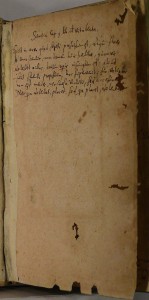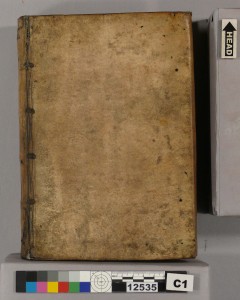The treatment Caesalpini’s De Plantis Libri XVI, 1583, stemmed from concern about the presence of mold spores. The book’s condition when it arrived was actually quite good. The sewing was still intact throughout the text block and it was still attached to the boards. Unfortunately, the fly leaves had separated from the text-block and were only just attached to the book’s cover. Someone had repaired the inner hinge in the front and back of the book and it was this repair that was keeping the fly leaf attached. Finally, after it was determined that the “mold” was not actually mold but soot and bacteria colonies, treatment could begin.
First, I began with dry cleaning each page with an Absorene Dirt Eraser sponge, also known as a dry cleaning or soot sponge, which we purchased from Gaylord. This sponge is designed to attract any surface dirt that may be present, though not necessarily visible. As treatment progressed, I began to find that the sponge was not picking up much dirt. This seems to indicate that the pages are actually quite clean on the surface, and that the smudges of soot have become embedded in the paper over time.
The next step was to reattach the fly leaves to the text block. I used usumino, which is a Japanese paper (from Hiromi) and wheat starch paste (from Talas) to attach the fly leaf to the text block. In order to repair the inner hinge in the front and back of the book, I used a thicker Japanese tissue called sekishu (also from Hiromi). This will help protect the the board attachment. As mentioned in the previous post, there was worm damage throughout the book. This was apparent on the fly leaves so I used a colored kozo Japanese tissue to repair any worm damage and to consolidate some areas where the damage was significant.
Finally, we wanted to try to clean the vellum covers with something a little stronger than a dry cleaning sponge but not so invasive that it damaged the integrity of the materials. After consulting with Michele Brown, I used cheese cloth dampened with ethyl alcohol to gently rub across the cover. Both boards and spine were cleaned in this manner. Though the change was not visible on the surface of the book, the white cheese cloth did become gray with dirt.
With the treatment of this book complete, I constructed a custom-fit clam-shell box with Velcro tabs for this item to live in for the foreseeable future.





Pingback: How fungi grew on Cesalpino | Cornell Mushroom Blog
Excellent.
Could you comment on use of fungal cell wall degrading enzymes (chitinases and beta-1-3-glucanases) in regard to “disloging” fungal mycelia?
Would such treatment by partial wall degradation, aid the removal of fungal pigments?
I note that the source of such enzymes would require monitoring, especially commercial enzymes which can include contaminants as proteases and cellulases. Thanks.
I will refer your comment to Professor Hodge.
I’m a mycologist, not a conservationist– my thoughts are from the fungus side of things. Partial digestion of fungal cell walls might help release pigments for some fungi that have dark cell walls. It’s worth noting that fungi growing “on” paper are usually really growing WITHIN paper. Hyphae growing inside the paper matrix or within individual fibers might be very hard to access with enzymes. Fungal pigments wouldn’t be digested by chitinases, and the pigments may or may not be associated with fungal cell walls. All that said, I think you could come up with an interesting set of experiments to look into this idea.